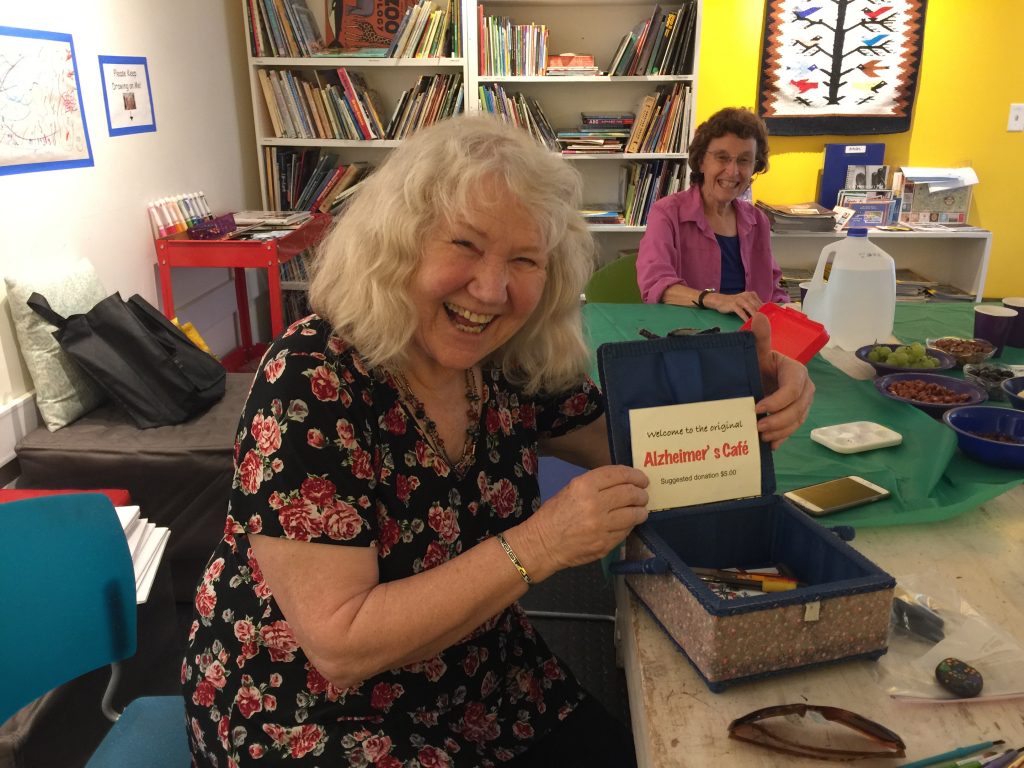Posts Tagged ‘arts’
Share Your Creative Arts Endeavors: An Opportunity for People who are Living with Dementia
I am honored to be part of the Arts Work Group at the Dementia Action Alliance, which is one of my favorite non-profits. Please share this information with those who might benefit. Warmly, Deborah
Dementia Action AllianceDementia Arts Fest 2019
Mike Belleville, 2018
The Dementia Arts Fest celebrates art made by persons living with dementia!
Call for Entries Deadline March 15, 2019
If you are a person living with dementia who engages in creative projects or you’re the leader of a creativity program for people living with dementia, we want to hear from you! You are invited to submit up to 3 pieces of art, ready to display – It’s an easy process to submit. This is what we need:
1. Photos of the artwork in JPEG, PDF, or PNG format. Label each image with your last name, the title.
2. A separate page:
Your name (artist’s name) and contact information.
List of your work with titles, dimensions, and media
3. Write down a brief description about how creating art impacts you and makes you feel. (around 200 words)
5. Email the above information to Karen Love at karenlove4@verizon.net.
Please let us know if you are submitting artwork on behalf of someone else.
Sale of Artwork
▪ Artwork accepted for the exhibition may be for sale, or may be marked as ‘NFS’ (not for sale). If the artwork is NFS, artists must include a prepaid return shipment label for UPS or Federal Express with their artwork shipment.
▪ If the artist’s work is sold, the Dementia Action Alliance [a 501(c)(3) charity] will receive 50% of the retail price set by the artist as a contribution.About the Dementia Action AllianceThe Dementia Action Alliance is a national non-profit organization of people living with dementia, care partners, dementia specialists and others making our nation a better place in which to live with dementia. www.daanow.org
Deborah Shouse is the author of Connecting in the Land of Dementia: Creative Activities to Explore Together and Love in the Land of Dementia: Finding Hope in the Caregiver’s Journey.
Dementia Friendly Cafes: Inviting Creativity and Connection
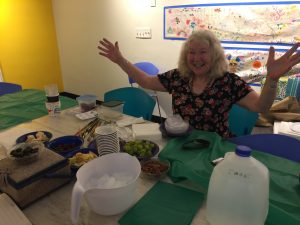 More than 10 years ago, Jytte Lokvig, PhD, was scanning the internet for additional information about dementia. On one of her Google searches she saw the words “Alzheimer’s Cafe” posted by Dr. Bere Miesen, who founded the first Alzheimer’s cafe in Leiden, the Netherlands in 1997. That phrase electrified her. She leapt out of her chair, much to the dismay of her cat, who was cozily sleeping across her feet, and declared, “I am going to make that happen in the U.S.!” She’d been working with people who were living with dementia in community settings for some years, orchestrating art, music, craft and other meaningful projects. But she felt something was missing. That something, she realized, was engagement in the community.
More than 10 years ago, Jytte Lokvig, PhD, was scanning the internet for additional information about dementia. On one of her Google searches she saw the words “Alzheimer’s Cafe” posted by Dr. Bere Miesen, who founded the first Alzheimer’s cafe in Leiden, the Netherlands in 1997. That phrase electrified her. She leapt out of her chair, much to the dismay of her cat, who was cozily sleeping across her feet, and declared, “I am going to make that happen in the U.S.!” She’d been working with people who were living with dementia in community settings for some years, orchestrating art, music, craft and other meaningful projects. But she felt something was missing. That something, she realized, was engagement in the community.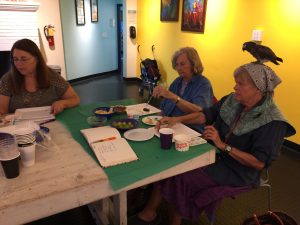 From that inspiration, Jytte created the original U.S. Alzheimer’s Cafe in Santa Fe, NM in 2008. Ten years later, there are more than 300 cafes in the US that invite creativity and connection through dementia friendly cafes.
From that inspiration, Jytte created the original U.S. Alzheimer’s Cafe in Santa Fe, NM in 2008. Ten years later, there are more than 300 cafes in the US that invite creativity and connection through dementia friendly cafes.  “Would you like a round plate of a square one?” she asked.
“Would you like a round plate of a square one?” she asked.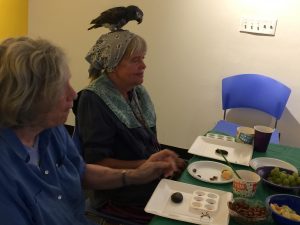
- Arrange a few snacks.
- Invite a guest or two, if you wish. This is an intergenerational project.
- Put a brightly colored plastic covering on the table.
- Squeeze some acrylic paint into a palette. Or use tempura or water colors.
- Offer a choice between two brushes.
- Offer a choice between two canvases: a cardboard paper plate, a river rock, paper, or other.
- Relax and let the painting unfold.
- If your loved ones need a little help, you can paint together. Or you can rest their hand on yours, while you paint to get them used to the movement of the brush.
- Appreciate the art by commenting on the color, the design, the shapes. Don’t ask them to identify the art: enjoy it as it is.
- Weave conversation into your time together.
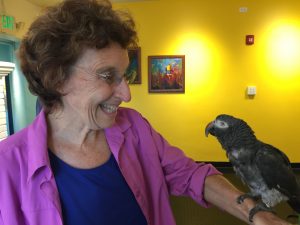
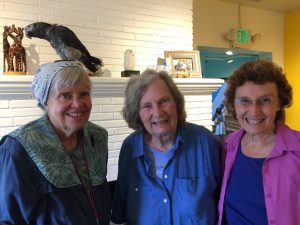
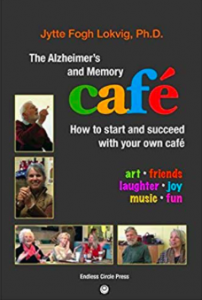

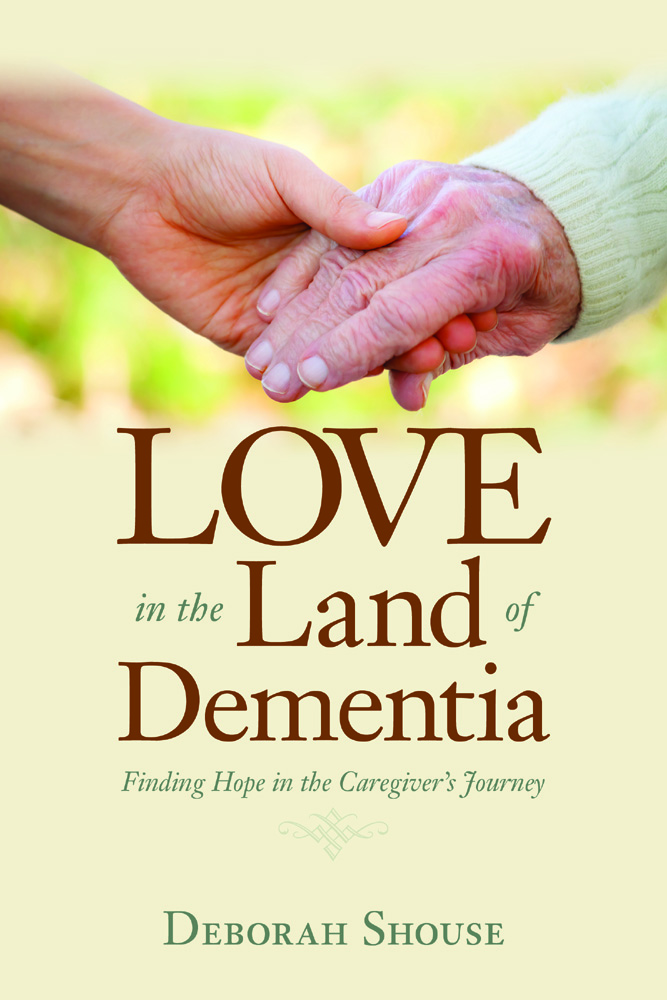
Orchestrating a Musical Conversation
When Ron’s dad was living in a memory care unit, Ron and I talked with the residents and their families, learning about their favorite songs. We orchestrated a sing-along and had fun working with everyone and putting together a scrapbook of each resident’s special tunes. The combination of music and conversation created a sense of community for us all. Julian West, who we met on a recent trip to London, is creating community through engaging people in music and dance. We really love the way he weaves the two art forms together and wanted to share his easy and adaptable ideas with you.
Julian West had no idea what would happen at the care facility, but he trusted it would be something wonderful. An accomplished oboist and a teacher at the Royal Academy of Music, Julian assembled a violist, a composer, a dancer, and an artist to share energy and their art with people who are living with dementia.
“This was an experiment to see what could happen,” Julian says. “We worked completely improvisationally.”
Once a week, for eight weeks, the troupe came to the residential care home and created a living arts experience with residents and staff. They began by inviting everyone to choose a percussion instrument, such as rain sticks, bells, shakers, tambourine, etc.
“We had a musical conversation,” Julian says. “One person made a sound and another answered. We also chatted a lot. People commented on the music or expressed an emotion or impression.”
The musicians added their instruments and the staff and residents joined in, through percussion and voice. They made fascinating sounds, like an improv jazz singer might do. The dancer twirled around in the center of their circle. Her free movements gave the group a focal point and inspired others to explore various movements.
“I let go of preconceptions and tried to create an open atmosphere,” Julian says.
The artists’ openness helped the “conversation” grow and blossom.
One woman who was living with dementia held up a tambourine, keeping it still and gazing at it as though it were a beautiful and revered object.
Julian’s first thought was, “She doesn’t know it’s a musical instrument”.
“I let that thought go,” he says. “I saw how expressive she was. Her interaction with the tambourine was beautiful and profound and she allowed us all to see the instrument differently.”
Even if you don’t have your own musicians and dancers at home, you can still create this supportive and creative atmosphere.
- Share a few percussion instruments, put on some music you both like, and make some joyful noises. Experiment with bee-bop syllables to add a sense of freedom.
- After the song, talk about the experience, what you liked, what you felt, and any other impressions that came up.
- Consider inviting a “guest dancer,” someone who likes to move to music, or a child of a friend who’s taking dancing lessons. Go ahead and add your own moves.
- Invite friends and family to join you. You’ll have something to laugh, and sing, and talk about.
For more information about Julian’s work, visit: www.julianwest.co.uk
Click for Poetry and Help Hundreds
My friend Molly has an exciting opportunity to expand the creative work she is doing with those who are living with dementia. She’s in the running for a small business grant from FedEx. Read this blog to learn more about the meaningful projects she is doing. If you are as inspired as I am, simply click on the link and vote for Molly and Mind’s Eye Poetry: http://bit.ly/1TgpDuJ
A brief silence unfolds while people consider.
“I used to wrap a scarf around my head in the convertible,” one woman says.
The woman sitting next to her smiles. “Scarves blow in the wind,” she says.
Molly mimics the scarf wafting in a breeze.
“If the scarf was music, what kind of music would it be?” Molly asks.
“Jazz,” a man says.
“Rock and roll.”
“Classical.”
Molly, who has an MFA and is the creator of Mind’s Eye Poetry in Dallas, Texas, reaches into her suitcase and brings out a small watering can. She continues the relaxed pacing, asking for impressions, invoking imagination, creating a sense of comfort and connection for this group of people who live in a memory care facility.
After 20 minutes of creative play, Molly takes out a slim book and says, “Here’s a poem about spring that I really like. See what you think.”
She reads the short, rhyming verse and asks for reactions. She then invites the group to contribute to a writing project.
“There are no wrong answers,” she assures them. “I’ll ask something and you’ll say the first thing that comes into your mind. For example, when I say ‘springtime’ what flowers do you think of? ”
“Daffodil, tulip, roses…” the group offers.
Molly writes down each flower and reads it back to the group.
“We have our first line of poetry,” she tells them.
“Imagine where the flowers are, in a vase, in the garden?”
“What colors are they? What time of day is it?”
Every question invites imagination and word-by-word, the poem emerges. After they’ve created three short poems, Molly shows them a piece of art and asks, “What do you see?” She captures their observations and uses their words to create a poem.
Here’s an example of a poem segment created after looking at Oriental Poppies, Georgia O’Keefe’s painting of two large orange poppies.
I see two evening gowns
on a diagonal, flowing.
I see a Scottie dog
prancing in a field of orange.
I see summertime in Santa Fe.
I see a black bird soaring into sunset.
“When I read back their words and say, ‘You all just wrote this,’ it’s very empowering,” Molly says.
For those at home who want to have a session of creative imagining, Molly has these suggestions:
Gather a few interesting objects, such as a recipe book, a nature photo, a pot holder, and one at a time, show them to your partner and ask, “Mom, what do you think about when you see this recipe book?” Give her plenty of time to respond and jot down her answers. If she asks, “Why are you writing?” tell her, “I value what you have to say.”
Soon, you’ll have a collection of words and phrases. You can take a photo of the object along with the poem it inspired and put them together in a book. #
Molly Middleton Meyer is the founder of Dallas-based, Mind’s Eye Poetry. To date, she has facilitated over 600 poems written by people with dementia. Mind’s Eye Poetry has been featured in U.S. News and World Report, the Huffington Post, the Dallas Morning News, Affect Magazine, Growing Bolder Magazine, and on NPR. When Middleton Meyer is not facilitating poetry, she writes her own. Her first book of poetry, Echo of Bones was published in 2014. For more information, contact Molly Middleton Meyer, M.F.A. Poetry Facilitator/Speaker at www.mindseyepoetry.com
Deborah Shouse is the author of Love in the Land of Dementia: Finding Hope in the Caregiver’s Journey.
COMING SOON: CONNECTING IN THE LAND OF DEMENTIA: CREATIVE ACTIVITIES TO EXPLORE TOGETHER
Dementia Café: Connecting through Donuts and Baseball
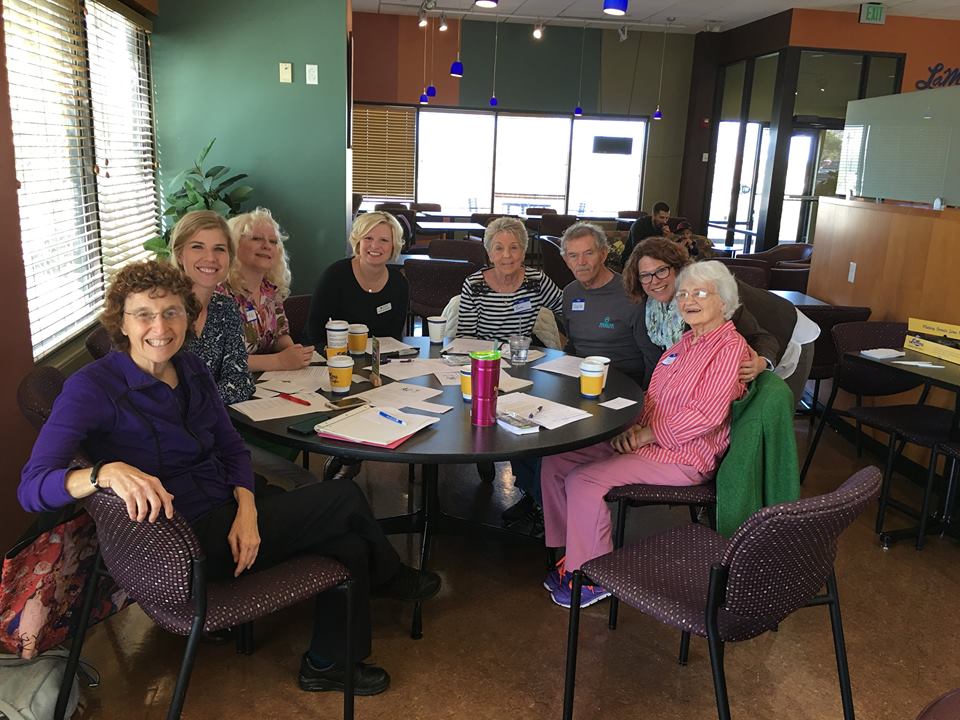
I’ve always enjoyed gatherings of creative people, so I was excited when I learned that Mandy Shoemaker was orchestrating a Dementia Café in our area. The premise is simple and fun: a group of people living with dementia, their care partners, and friends get together in a public space for a facilitated time of conversation, sharing, and creativity.
Mandy’s café took place in Lamar’s, a locally esteemed donut shop with a quiet atmosphere and a spacious seating area. Eight of us gathered around a table and Mandy opened the conversation by showing us a black and white photo of a baseball player laying on a field, next to a fence, apparently knocked out.
“Babe Ruth,” she told us. “He was running backwards to catch a ball and crashed into the barrier.”
We all nodded in sympathy, then began sharing baseball stories. Charlie had played in his youth and he and his wife Barb were ardent Royals fans. Courtney had played softball in high school. Fran, who grew up in the 1930’s in rural Mississippi, never had a chance to play sports but she liked hearing about the game.
“Did you ever listen to baseball on the radio?” Mandy asked her.
“In those days, not everyone had everything,” Fran said. “I don’t think we even had a radio.”
Barb remembered being on her grandparent’s farm, huddled around the radio, listening to the Yankee’s games.
“Have you ever heard the poem Casey at the Bat?” Mandy asked.
“I memorized it at school,” Charlie said.
 We took turns reading the dramatic poem, discussing such vivid terms as “when the dust had lifted” and “Casey lightly doffed his hat,” and one ball player was a “lulu” while another was “a cake.” The tension built and we chanted the last verse together. (Seek out this poem if you want to know what happened in Mudville that day: www.baseball-almanac.com/poetry/po_case.shtml )
We took turns reading the dramatic poem, discussing such vivid terms as “when the dust had lifted” and “Casey lightly doffed his hat,” and one ball player was a “lulu” while another was “a cake.” The tension built and we chanted the last verse together. (Seek out this poem if you want to know what happened in Mudville that day: www.baseball-almanac.com/poetry/po_case.shtml )
We then created a group poem, each contributing an answer to “Baseball is…”
I left the café feeling exhilarated and connected. Baseball was a catalyst for a great conversation that included life in the 1930s, family origins, Memphis, Elvis, baseball cards, Abbott and Costello, poetry, women and sports, fathers, hard work, radio programs, and more.
“It is our goal to create a more dementia-friendly community,” Mandy says. “Part of that is creating safe places for people with dementia to come and be a part of a group, with no expectations. The café invites people to just get out, be creative, and have fun.”
The KC Memory Café will meet on the second Tuesday of each month. To keep up to date, follow our facebook page at www.facebook.com/KCMemoryCafe
Create Your Own Cafe
You can also create your own café for two or more. Here are a few tips:
Select a public meeting place that serves refreshments and is reasonably quiet.
Let go of expectations and create a supportive atmosphere. You are here to express yourselves and connect.
Pick a broad topic that you are both interested in. Examples include seasons, sports, nature, games.
Start with a visual stimulation, such as a photo. Ask open-ended questions that invite imagination, such as “What do you see in this picture?” or “What do you think is going on?”
Allow the conversation to flow. The topic is a mere catalyst for ideas and communication.
Print out a familiar poem to read together. Enjoy the drama of reading aloud and invite comments on the poem.
For more about starting a café, visit
http://www.alzheimerscafe.com/public.html.alzheimersatoz.com/Welcome.html
Deborah Shouse is the author of Love in the Land of Dementia: Finding Hope in the Caregiver’s Journey.
COMING SOON: CONNECTING IN THE LAND OF DEMENTIA: CREATIVE ACTIVITIES TO EXPLORE TOGETHER
Four Reasons You’ll Want to Read This Book
The thoughts creep in, quietly, sneakily, like Sandburg’s fog “on little cat feet.” I walk into the living room and puzzlement seizes me. I ask myself, “Now why am I here?” I am writing to my cousin and suddenly can’t remember his life partner’s last name. And then there’s the mysterious case of the forest green shirt in the night, gone missing now for four and a half weeks.
Perhaps you, too, deal with these flash thoughts: “Am I feeling the first confusions of the deeply forgetful?” (That’s the beautiful way Stephen G. Post, PhD, refers to memory loss.)
“If I should become more deeply forgetful, I want to be sure you read this book,” I tell Ron.
“This book” is I’m Still Here by John Zeisel, PhD, and I felt enveloped with grace, compassion, and excitement while I was reading it. John is the president and cofounder of Hearthstone Alzheimer Care, and a writer, professor, and vigilant advocate for those living with dementia.
He writes about how he’s been transformed by working with people living with dementia. He orchestrates care partner conversations, where they discuss the gifts of being present for their loved ones with dementia. He’s brimming with creative ideas and activities that bring life and fun to care partners.
With his colleague, Sean Caulfield, he drew into existence the Meet Me at MOMA arts program for those living with dementia, and now offers a variety of artistic and creative programs all over the world. He’s involved in a number of other innovative programs through his foundation, including It Takes a Village, designed to keep people living with dementia connected to their communities and to themselves.
Here is one of John’s thoughts that really speaks to me: “Everyone has his own unique capabilities. … It is our job to uncover, celebrate, and embrace these abilities, so everyone living with Alzheimer’s maintains dignity, independence, and self respect.”
Those words are easily just as true if they read: “Everyone has his own unique capabilities. … It is our job to uncover, celebrate, and embrace these abilities, so everyone maintains dignity, independence, and self respect.”
If you want to feel more connected to someone who’s living with dementia, if you want to celebrate yourself as a care partner, if you want to understand more about the dementia experience, if you want a dash of inspiration and a long cool drink of hope, you’ll love reading this book.
To Learn More about The I’m Still Here Foundation’s programs, visit www.ImStillHere.org
To Learn More about Hearthstone Alzheimer Care, visit www.TheHearth.org
To learn more about John, just Google his name
To order John’s book, visit Amazon.com or another online bookstore
Deborah Shouse is the author of Love in the Land of Dementia: Finding Hope in the Caregiver’s Journey.
Three Great Reasons to Go Out for Art and Culture
Art shows that what people have in common is more urgent than what differentiates them. – John Berger
Teri Miller, with the Alzheimer’s Association Houston & Southeast Texas Chapter, has witnessed the power of creativity and the arts. As the Early Stage Program Manager, Teri collaborates with Houston arts and civic organizations and encourages people living with dementia to attend the events, which have included viewing art, doing photography workshops, creating poetry, and spending time in nature.
“Attending these activities offers people a sense of normalcy and gives them something to put on their calendars,” she says. “When they attend with friends or care partners, they have a shared experience to discuss and they also have ‘news’ to share with friends and visitors. Even people who say, ‘Oh, I don’t care for museums,’ usually have a great time.”
Sam is just one example. He grew up in a small Texas town and has been attending one of Teri’s early stage support groups. His wife, who cares for him at home, attends a care partner’s group. When Teri formed a partnership with the Houston Museum of Fine Arts, she invited her early stage group to attend an arts tour with their care partners.
When Sam heard the invitation, he rolled his eyes and said, “I’ve never been to a museum and I’m not about to start up now.”
But the next week, Sam was there, signed up for the tour.
“I’m glad you’re here,” Teri told him. “What made you change your mind?”
“Well, my wife really wanted to go. She does so much for me and I figured I’d like to do something for her.”
Teri expected Sam to sit back silently, arms folded over his chest, when the docent asked, “What does this painting make you think of? Has anyone ever been in a similar setting?” To Teri’s surprise, Sam had opinions on each of the three pieces they discussed.
Sam’s wife smiled as Sam told Teri, “Originally, I didn’t want to go because I was worried I wouldn’t have anything meaningful to contribute. But I guess you don’t have to know anything about art to enjoy the museum.”
Sam and his wife discussed the experience all the way home, adding a new topic to their usual conversations. Discussing the art opened up chances to reminisce and connect. Plus the experience gave them something interesting to share with their grown children and visiting neighbors.
Like many art partnerships around the country, Teri was inspired by Meet Me, the MoMA’s Alzheimer’s Project for people living with dementia. Houston benefitted from MoMA coming to train their docents. The program offers comprehensive guidelines for visiting a museum or viewing art at home.
http://www.moma.org/meetme/practice/index
For more about Houston’s art viewing program, visit
http://www.creativeaging.org/creative-aging-program/6523
Deborah Shouse is the author of Love in the Land of Dementia: Finding Hope in the Caregiver’s Journey.
Transforming Attitudes Through Art
“Art enables us to find ourselves and lose ourselves at the same time.”
~ Thomas Merton
The art therapist shows up at our house, bumping along a rolling suitcase filled with supplies. Her hospice client, my life partner Ron’s 97 year-old mother Mollie, is slumped on our sofa, her head thrown back, her eyes closed. As forgetfulness nibbles away at her mind, her indifference increases.
“Hi Mollie, I’m Denise the art therapist.” Denise introduces herself again, even though they have met several times.
“Whatever,” Mollie says.
Denise unzips her suitcase and begins taking out art supplies: pink, red, yellow and green bolts of crunchy tissue paper, a plastic box of small colorful felt squares, hearts, circles, stars and triangles, two bottle of Modge Podge glue, and several paint brushes.
Denise settles beside Mollie, with a black piece of paper and some red and pink tissue.
“What color do you like best?” she asks.
Mollie shrugs but points to the pink. Denise paints a strip of glue onto her paper and sticks a crumpled bud of rose paper.
“Mollie, what shape appeals to you?” Denise asked, offering a purple felt square and a red triangle.
Mollie points to the square.
“I don’t know what to do,” Mollie says, a frequent refrain. Her encroaching confusion has knocked the center out of her normal confidence and rendered her nervous.
“Just sit here with me and help me make this picture,” Denise says.
Denise offers Mollie a choice between lilac and purple tissue, then sea green and dark green options.
“You’re an artist,” Mollie says, looking at the tissue flowers that have miraculously bloomed on the page. A garden is beginning. “You’re really an artist,” Mollie repeats and Denise smiles.
“Thank you Mollie. Can you take this brush and spread the glue?”
The brush shakes in Mollie’s hand but she manages to even out the glue, preparing the page for a tangerine and lemon colored blossom.
“This is art,” Mollie says.
“You like art, don’t you?” Denise says. “You have quite an art collection.”
Mollie nods. As she spreads the next glump of glue, Denise asks her about the antique shop she ran for many years and about her travels to get art. Mollie answers but she seems more focused on the page in front of her, the new art that Denise is bringing into her life.
Deborah is the author of Love in the Land of Dementia: Finding Hope in the Caregiver’s Journey.
Four Ways Stories Make a Difference
You may have heard that the world is made of atoms and molecules, but it is really made up of stories. — William Turner
Recently we listened to an excellent webinar featuring Marc Wortmann, Executive Director of Alzheimer’s Disease International. He said, “Sharing your stories is one way you can make a difference.” I asked several writers and storytellers to share their motivations and insights.
Sharing Stories Reduces Isolation
“Journaling helped me maintain my sanity when faced with the unpredictability of my parent’s behavior due to cognitive decline. Sharing my stories with other caregivers helps us to realize we aren’t in the boat alone. As the saying goes, ‘A shared burden lightens the load,’ and hopefully reduces our stress levels and perhaps even elevates our coping skills.” — Vicki Tapia, author, Somebody Stole My Iron. www.SomebodyStoleMyIron.com
Writing Stories Clears the Mind
“Just writing down my thoughts on scraps of paper helped me clear my head and face my day. I wrote about the rough spots and about my changing relationship with my mom. I found it helpful to read my stories aloud to people in my writing group; it was comforting to share and hear that people identified with me. As caregivers we often feel invisible. I wrote my book because I wanted to share my day-to-day life as a caregiver.” — Martha Stettinius, author, Inside the Dementia Epidemic: A Daughter’s Memoir, http://www.insidedementia.com
Using Stories Ignites Public Conversation
“When I was writing my book, I had one objective in mind: I wanted to use our family story to ignite a public conversation about care. Not just any old conversation — I wanted people to talk about social policy around the dinner table the same way folks discuss politics. I wanted our story to be anyone’s story.” — Donna Thomson, The Four Walls of My Freedom: Lessons I’ve Learned From a Life of Caregiving www.donnathomson.com
Telling Stories Makes a Difference
“As a speechwriter, I’ve known that stories can make any topic come alive. As a speech coach, I’ve seen that otherwise ‘ordinary’ speakers can produce ‘extraordinary’ presentations by including memorable stories. Storytelling has the capacity to make a difference anywhere. When my mother suffered a sudden stroke, I told her stories. She couldn’t speak, but her face lit up as I spoke. She liked the stories I’d tell her — simple stories about our friends, our home, the weather, and good times. You don’t have to be skilled or sophisticated to let storytelling make things better. You just have to get started.” — Joan Detz, author of How To Write & Give A Speech www.joandetz.com/speechwritingblog
Deborah is the author of Love in the Land of Dementia: Finding Hope in the Caregiver’s Journey.

